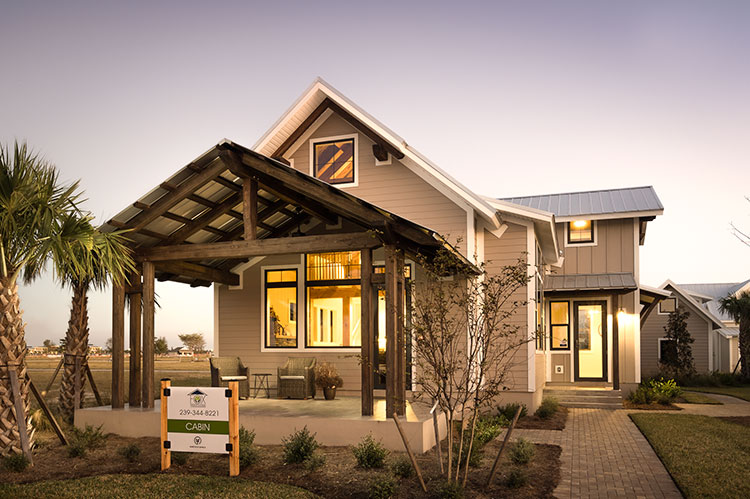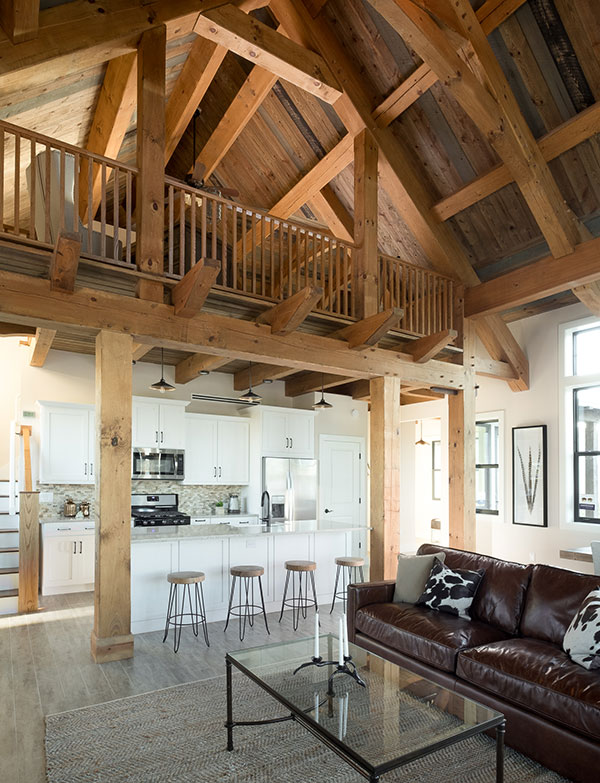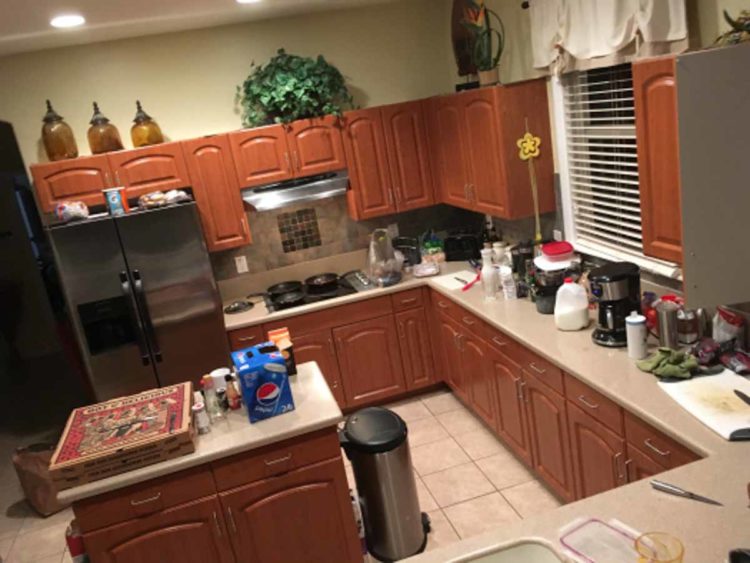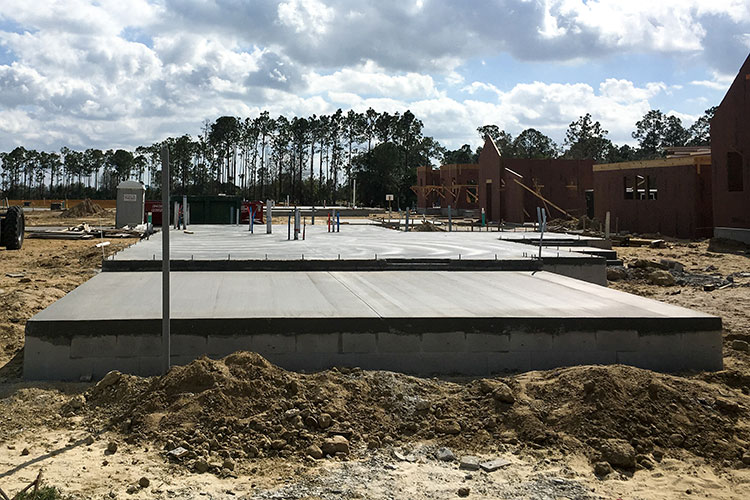
We are very excited to be a part of this solar powered city in Florida. Developers aim to provide 19,000 homes with power from a 440 acre solar field. Homes like our cabin were chosen because of their ultra-efficient building envelopes and their artful designs.
We always feel lucky when our projects end up in able hands. Here’s a great example of what contemporary decorating and a high-end finish can do. The project has come a long way since we left but we’ve been keeping tabs on the exciting efficiency tech at Babcock Ranch. (See more on the timber frame community center we built for Babcock at our Lake House page.)



Timberbuilt’s main design section has a dedicated Cabin page that includes layouts, dimensions, 3D models and more pics.
JANUARY 30, 2017
It’s time to get up close and personal with Team Timberbuilt. See how our homes are built from the best view in town — on the ground, with the crew, as they assemble SIPs and timbers. It’s an easy look at our on-site process from start to finish.
December 14, 2016
Field Notes: Flight to Buffalo cancelled.
Instead, flew into BWI, rented an SUV and drove the remaining six hours to Buffalo. Whiteout conditions on the road. Worst I’ve ever been in. Mike and I had to stick our heads out of the moving car at one point to try to see the lines on the road but home safe now, mission accomplished.
DECEMBER 13, 2016
The Cabin down in southwest Florida is completed. This is a good look of what’s included in our package. What you see here is basically what all of our builds look like when we are done. Now it’s your local contractor’s turn to finish it out.

And some more pics from the job:
DECEMBER 8, 2016
Field Notes: We travel light.
Our systematic building style means that before we set foot on a job site we have a precise number on our materials. Drive by most construction projects and you’ll see a massive overflowing dumpster. Not ours. The waste we produce is almost non-existent. Other than plastic packaging, chunks of leftover masonry debris from the foundation, and a cracked fiberglass ladder, our dumpster here is practically empty. I could fill a dumpster this big with stuffed animals and shoe bins from my basement alone.
Our personal travel kits are light too. We rent houses together, not hotels which lets us share our daily expenditures and further minimizes waste. We’re piled into a rental on a small canal in Cape Coral. Up at 5, home around 7 (traffic, ugh). By the time we get home there’s really only time to shower, make the next day’s lunch, make dinner, eat, and sleep. Pantry organization falls off the list. Our kitchen counters are packed. I’ve never seen so many meat products jammed into a refrigerator.

DECEMBER 8, 2016
Field Notes: Timber Time

Once we get a bunch of the walls standing (and temporarily braced) we start setting timbers into their pockets. First we build our anchors out of regular 2x6s.

Then, we start setting them into place.

Then, we reluctantly pose for photos..

DECEMBER 7, 2016
Field Notes: SIPs – Bigger Is Better (And More Efficient)
Apparently our SIPs supplier, Insulspan, is the best in the business. In addition to all the mathematical mumbo jumbo that goes into explaining their energy efficiency, they send us some really, really big panels.
This solar city is hosting a bunch of different builders. Right now all these different builders are constructing model homes so potential buyers can come and walk around all the different houses and choose which one they want. Lots of new energy tech is being used in the builds so it’s not surprising that the guys building the house next to ours are also using SIPs for the walls.
What is a bit shocking (remember I’m new) is seeing how small their panels are. These guys are using 8’x4′ wall panels and it’s taking them tons of time to connect them all individually. Meanwhile, we’re using 24’x8′ panels. Our things are like Macy’s Parade sized walls compared to theirs. This crew next door literally stopped working today to watch us set a fully constructed three story wall in place. I can’t imagine how long it would’ve taken them (or how hard it would be to air seal all those joints) but right after we finished their foreman came over and asked us where we get such big panels.
At the very least, working with large materials leaves less room for error.
DECEMBER 6, 2016
Field Notes: Smooth and Slow Is Fast
There is ZERO fat here. Everyone has a task. Despite the speed at which everything seems to be happening, pace is not nearly as important as perfection.
Every task is a building block which can make the next task either easier or harder. I reflect on this as I spend twenty minutes pulling nails from a line I shot incorrectly, while trying to rush. The SIPs are cut on a machine to precise measurements. If they aren’t put together properly, with all gaps fully closed, they will make our timbers harder to set into place. (Or so I’m told)
This house will use a hybrid timber frame, which means that both the timbers and the wall panels act as the structural support system. They rely on each other for support. The panels have pockets for the timbers to sit in. The timbers have blocks on them to anchor them into the pockets.
Incorrectly joined SIPs panels (like mine) will make the process much harder. I keep pulling nails.
DECEMBER 5, 2016
Field Notes: New Guy
The crew is justifiably suspicious of me. I’m the new guy, ten years older than everyone, and carrying a camera with my tools. I was hired to help continue to build our business, but I’ll be traveling with the install team off and on so I can learn from the inside out.

Staying busy is tough when you’re not sure what to do and this team thrives on staying busy. It’s competitive working and it’s contagious, which is why I hate my ineffectiveness so far. I want to jump into the mix, to show the guys that I’m not afraid of hard work but I’m not sure where I fit so I spend a lot of time wandering around, picking up the mostly non-existent trash, trying to keep the jobsite clean.
We spent the day putting walls together on the ground.
These SIPs (structural insulated panels) are basically like giant insulation sandwiches with plywood for the bread. The technology is new to me, but I’m a homeowner, with a drafty house in Buffalo, NY so I’m already jealous. One summer we had a work crew blow cellulose insulation into our walls. Five years later, during an energy audit, I got a chance to use a thermal camera to see how the insulation was performing. It was a joke — everything had settled down, compressing towards the bottom of each wall cavity, and leaving big gaps all over the place. With these SIPs, the insulation is rigid so it never settles AND it creates an airtight seal. Now if I could only figure out how to keep up with the team instead of getting in the way…
I hover around asking what to do. By lunch I realize my best bet is to keep everyone else productive. I hustle to keep all the glue guns full. We use a flexible sealant on every joint of every wall to keep the house air sealed and to maintain a continuous vapor barrier — it’s a meticulous, unending process — so we go through the tubes of glue constantly. I end up with the stuff all over me but at least I’m making a mess in a useful way. I rush sledge hammers from man to man. I set and release pole clamps, which we use in tandem with the sledges to draw the walls together.
By quitting time I’ve abbreviated the process into something I can understand:
1. Locate and sort the SIPs wall pieces by their marked Letter/Number combination
2. Sort the pieces together that go together
3. Glue the connection points
4. Use sledge hammers and clamps to push the separate panels into a tight fit
5. Use the nail guns to stitch the panels together, firing a nail every four inches.
6. Repeat until all walls are built, laying flat on the ground.
DECEMBER 4, 2016
Field Notes: Starting the cabin
Arrived in Fort Myers, FL on a pre-dawn flight with our foreman and got to the job site early to check out the foundation which is always poured according to our specs (by the client) before we arrive.

We measured and chalked the layout lines, leaving ourselves with a perfectly square, precise outline on the concrete of where our walls and timbers are going to sit. The masonry guys left all kinds of concrete chunks which are not fun underfoot when you’re trying to move fast and safely among thousand pound timbers and a forklift so we spent some time cleaning the ground up before our truck arrived from where we loaded it in our shop yard back in New York.
On site, waiting for us when we arrived, was an 8,000 pound extendable forklift, which we used to unload and strategically stack the timbers around the site.
We’re in a solar-powered city, surrounded by an ecological preserve, under western Florida sunshine, staring at an empty concrete pad. Very excited to get this sucker built.
Timberbuilt’s main design section has a dedicated Cabin page that includes layouts, dimensions, 3D models and more pics.








